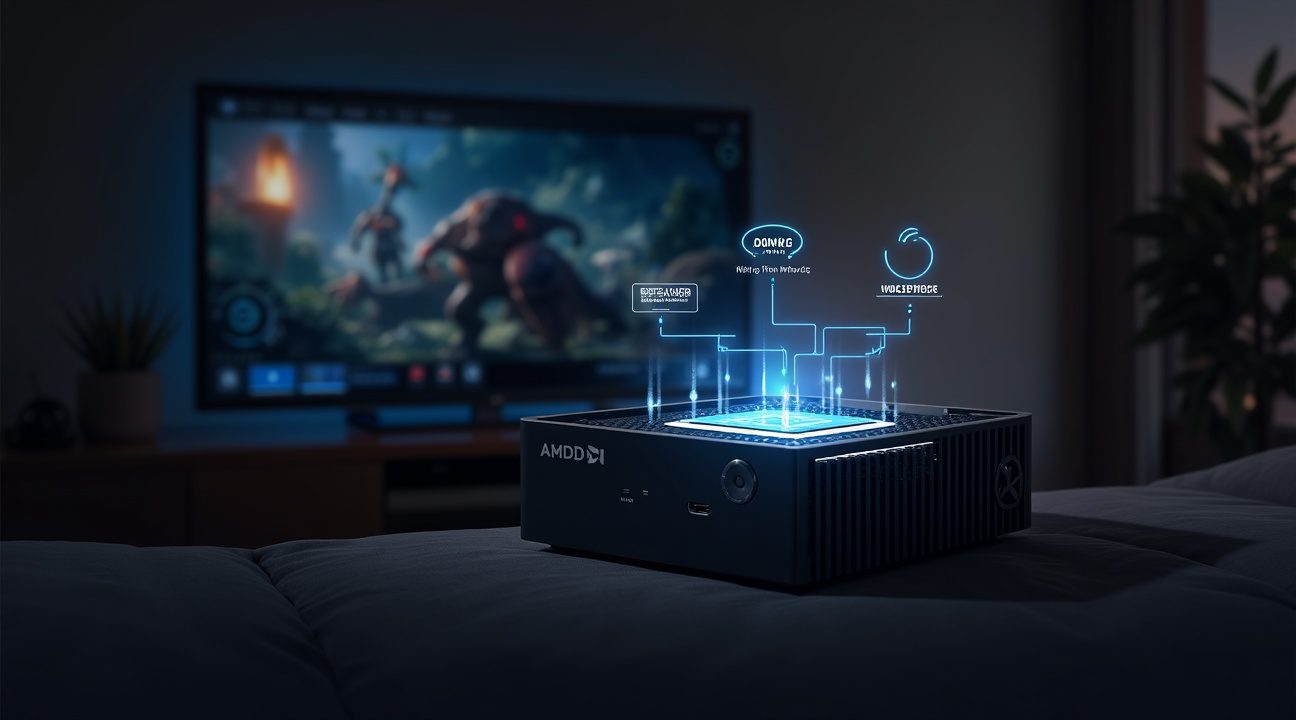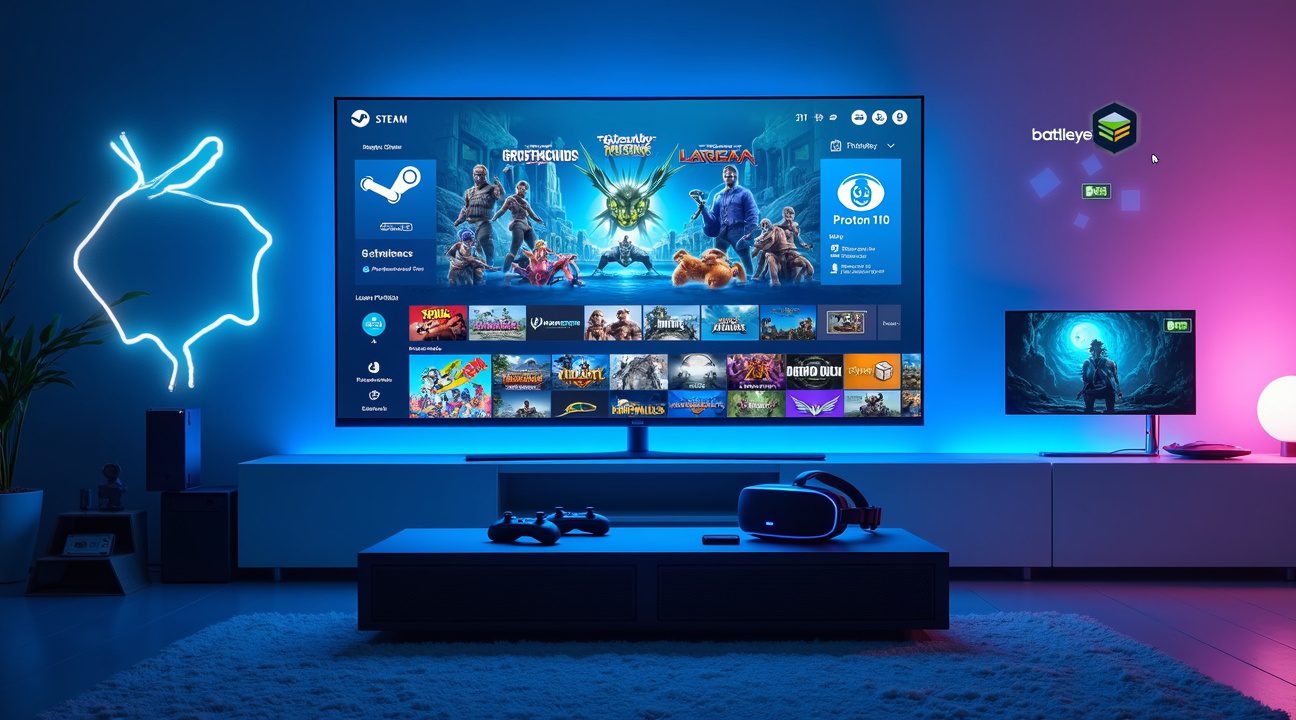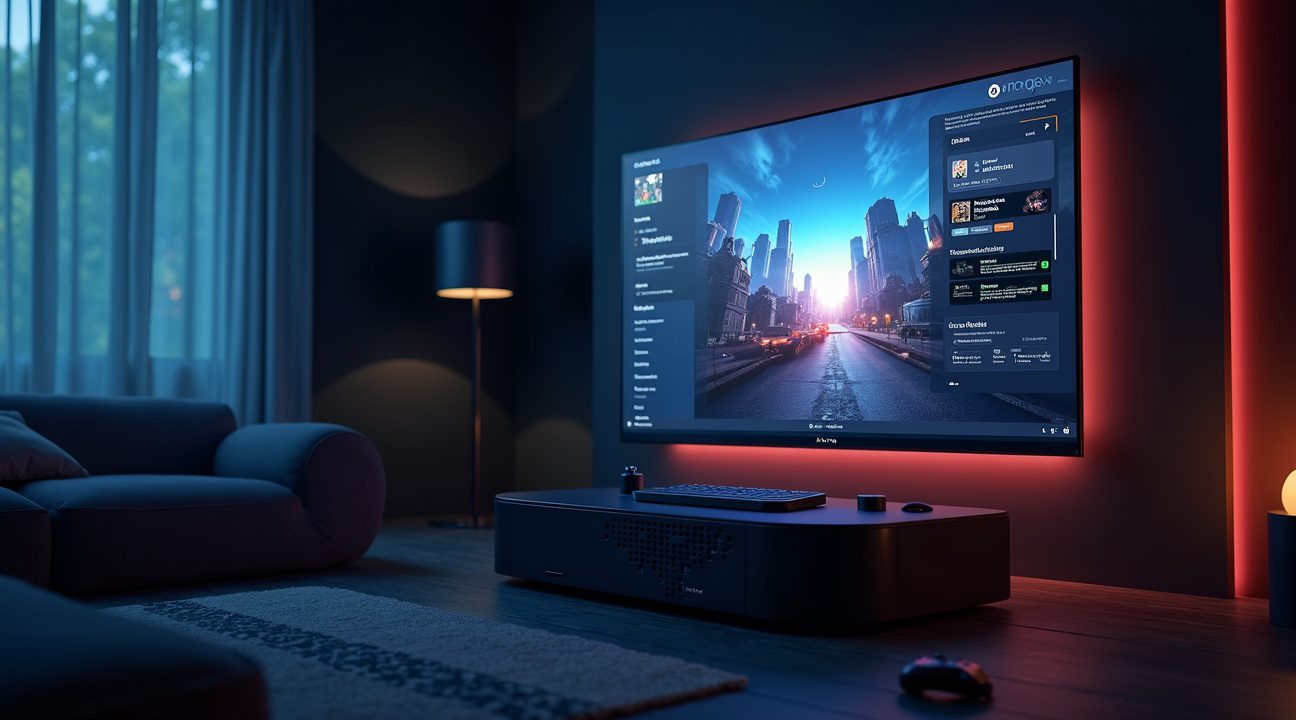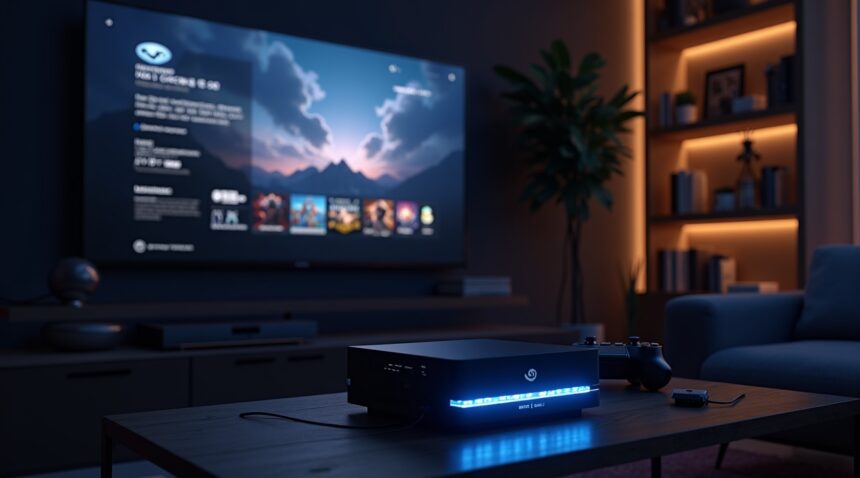Valve has officially announced the return of the Steam Machine as a compact, in-house built living room console set to launch in 2026, marking a strategic shift from their previous third-party manufacturer approach.
This revival leverages the proven success of Steam Deck’s SteamOS and Proton technology to deliver seamless access to tens of thousands of Windows games on a Linux-based console platform. Unlike its 2015 predecessor, this version is entirely controlled by Valve, promising uniform hardware performance, better support, and a more streamlined gaming experience.
Key Takeaways
- Valve will manufacture the Steam Machine in-house, ensuring unified hardware specifications and eliminating previous fragmentation issues.
- The console features semi-custom AMD hardware with Zen 4 CPU cores and RDNA 3 graphics, targeting 4K 60fps gaming in a compact form.
- Proton 10.0-3 compatibility layer provides seamless access to over 50,000 Steam games on Linux-based SteamOS with minimal setup.
- Modern connectivity is included, such as USB-C, HDMI 2.1, Wi-Fi 6E, 16GB LPDDR5 RAM, and expandable storage options.
- Valve targets a 2026 launch to directly compete with next-gen PlayStation and Xbox consoles.
The gaming landscape stands on the brink of significant change as Valve prepares to reintroduce the Steam Machine with a completely revamped approach. This time, Valve emphasizes direct control over hardware and software integration to ensure a seamless user experience.
Steam Deck’s remarkable success has equipped Valve with practical knowledge in both hardware optimization and software compatibility. These learnings have directly influenced the new Steam Machine’s development philosophy.
Hardware Specifications and Performance
The new Steam Machine utilizes semi-custom AMD silicon designed for powerful and efficient living room gameplay. Its Zen 4 CPU core architecture ensures ample processing capabilities to handle modern titles, while RDNA 3 graphics provides high-end visual fidelity.
Valve aims to support 4K gaming at 60fps as standard, placing the Steam Machine head-to-head with Xbox Series X and PlayStation 5. Early test results suggest it maintains consistent performance without thermal throttling in compact usage scenarios.
Noise levels have been a critical focus. Advanced cooling systems and smart fan curves enable quiet operation suited for living room gaming while preserving performance during extended sessions.
Software Integration and Game Compatibility
Proton 10.0-3 is Valve’s latest compatibility technology, enabling users to run Windows-only titles effortlessly on SteamOS. With compatibility levels exceeding 85% across the Steam catalog, most games launch without additional setup.
The process is highly user-friendly: just download and play through the Steam interface. Performance loss is negligible, typically within 5–10% of native Windows performance.
Anti-cheat compatibility—once a major hurdle—has significantly improved due to ongoing collaboration with major publishers. Competitive multiplayer titles are now fully functional through Proton.
Market Positioning and Strategy
Valve’s aggressive pricing model takes advantage of its digital storefront revenue to offer competitive console pricing without compromising on features. This model could undercut traditional consoles while offering a richer ecosystem.
The 2026 launch aligns with the anticipated mid-cycle refresh of both Sony and Microsoft’s current-gen consoles. This timing gives Valve an opening to compete directly at a hardware level from day one.
An additional edge is Steam’s ecosystem continuity. Users will have instant access to their existing libraries, offering immediate value and lowering entry barriers for current PC gamers considering a living-room solution.
Technical Connectivity and Expansion
Connectivity and expansion are tailored to modern users:
- USB-C ports support data transfer, charging, and accessories for streamlined connectivity.
- HDMI 2.1 compatibility ensures features like VRR and HDR for smoother gameplay and vivid visuals.
- Storage expansion includes M.2 NVMe support and hot-swappable microSD cards for convenience and flexibility.
- Wi-Fi 6E and Bluetooth support guarantee fast wireless performance and compatibility with gaming peripherals.
These enhancements cater to diverse user needs, from hardcore gamers to media consumers, and ensure the console remains relevant for years to come.
Competitive Landscape Analysis
Currently, Xbox and PlayStation dominate the console space through exclusive content and loyalty within established ecosystems. However, Steam Machine introduces a different angle: platform openness and extensive backward compatibility.
Unlike other consoles, SteamOS gives developers flexibility and independence, removing many barriers to entry. This especially benefits indie developers and studios looking to escape rigid platform certification processes.
Steam Machine embraces cloud gaming features via native support for Steam’s Remote Play and services such as NVIDIA GeForce NOW, boosting the system’s capabilities beyond its hardware constraints.
Manufacturing and Quality Control
Valve has opted for a fully in-house manufacturing model, ensuring consistent quality standards that were lacking when multiple manufacturers built different Steam Machine iterations in 2015.
Utilizing experience gained from Steam Deck production, Valve is well-positioned to handle supply chain complexities and global distribution smoothly. Lessons from Steam Deck’s launch have been applied to improve component sourcing and production scalability.
Quality assurance includes extensive compatibility testing and environmental tests to validate the hardware across various use conditions, ensuring long-term durability and product reliability.
The return of the Steam Machine signals Valve’s most ambitious hardware endeavor since the original prototype. By synergizing proven software, powerful hardware, and efficient manufacturing, Valve is poised to make a meaningful impact on the console landscape. Whether this revival succeeds will ultimately depend on market adoption, but early signs point to a promising future.
Valve Officially Revives Steam Machine for 2026 Launch
Valve has confirmed the official revival of Steam Machine as a compact, in-house built living room gaming console set to launch in 2026. This announcement marks a significant shift from the company’s previous approach, where they partnered with third-party manufacturers to create various Steam Machine configurations.
Plug-and-Play Gaming Experience
The new Steam Machine prioritizes convenience through its plug-and-play design philosophy. Unlike its predecessors, this iteration focuses on delivering PC-level performance within a console-like form factor specifically optimized for living room entertainment. I expect this approach will appeal to gamers who want the flexibility of PC gaming without the complexity of traditional desktop setups. The console targets users seeking Steam OS and Proton compatibility in their living spaces.
Hardware Specifications and Features
The revived Steam Machine incorporates several practical hardware features that enhance user experience:
- M.2 storage upgrade support in both 2230 and 2280 formats for flexible expansion options
- Hot-swappable microSD storage capabilities for additional game library space
- Quiet operation profile specifically engineered for couch and TV play scenarios
- Revised Steam Controller included with each unit
- Complete cable package for immediate setup and use
These specifications demonstrate Valve’s commitment to addressing the pain points that affected earlier Steam Machine iterations. The storage flexibility particularly stands out, allowing users to expand their game libraries without complex installation procedures. Hot-swappable microSD functionality means gamers can quickly switch between different game collections or share storage between devices.
The quiet operation profile addresses a common concern with living room gaming setups, where console noise can disrupt the entertainment experience. I believe this focus on acoustics will make the device more appealing to families and shared living spaces.
By shipping each unit with a revised Steam Controller and all necessary cables, Valve eliminates the additional purchases that often frustrate console buyers. This complete package approach aligns with the company’s plug-and-play philosophy and reflects lessons learned from the Steam Machine revival development process.
The 2026 launch timeline provides Valve sufficient time to refine the hardware and software integration while building developer support for the platform. This strategic timing also positions the console to compete effectively within the evolving gaming hardware trends landscape.
Semi-Custom AMD Hardware Targets 4K 60fps Gaming
Powerful AMD APU Architecture
The upcoming Steam Machine leverages a semi-custom AMD APU that combines cutting-edge Zen 4 CPU cores with RDNA 3 graphics architecture. This powerful combination delivers the performance needed to handle demanding games at 4K resolution while maintaining smooth 60 frames per second gameplay. The custom design allows Valve to optimize the hardware specifically for SteamOS and Proton compatibility, ensuring games run efficiently across the platform’s extensive library.
This approach follows current gaming hardware trends that prioritize integrated solutions for compact form factors. The AMD APU eliminates the need for separate CPU and GPU components, reducing both size and power consumption while delivering console-level performance in a living room-friendly package.
Modern Connectivity and Storage Options
The system includes comprehensive connectivity features that address today’s gaming requirements. Advanced ports and wireless capabilities ensure seamless integration with modern displays and peripherals:
- USB-C ports for versatile device connectivity and fast charging
- HDMI 2.1 support for high-bandwidth 4K gaming and variable refresh rate displays
- Wi-Fi 6E connectivity for low-latency online gaming and fast downloads
- Bluetooth 5.3 for wireless controllers and audio devices
Storage and memory specifications reflect serious gaming aspirations. The machine ships with 16GB of LPDDR5 system RAM, providing ample bandwidth for demanding titles and smooth multitasking. Starting storage capacity reaches 512GB with upgradable M.2 drive slots for expansion, allowing users to grow their library without limitations.
HDMI 2.1 inclusion particularly stands out as a forward-thinking decision. This standard supports 4K at 120Hz, Variable Refresh Rate (VRR), and Auto Low Latency Mode (ALLM), features that enhance gaming experiences on compatible displays. The specification ensures the Steam Machine remains relevant as display technology advances.
The revival of Steam Machines represents Valve’s refined approach to living room gaming. Previous iterations struggled with hardware fragmentation and software compatibility issues. This new unified design addresses those concerns while delivering performance that competes directly with traditional consoles. The combination of custom AMD silicon and SteamOS optimization creates a compelling package for PC gaming in the living room environment.

SteamOS and Proton 10 Enable Tens of Thousands of Windows Games
The latest Steam Machine leverages SteamOS, which is built on Arch Linux and offers users a dual-mode interface that adapts to their preferred gaming style. I can switch between a console-oriented Big Picture Mode for traditional living room gaming and a full desktop experience powered by KDE Plasma. This flexibility makes the system suitable for both casual console gaming and more intensive PC tasks.
Proton 10.0-3 Delivers Seamless Windows Game Compatibility
At the heart of the new Steam Machine’s impressive game library access lies Proton 10.0-3, Valve’s latest compatibility layer. This technology enables users to run tens of thousands of Windows titles seamlessly on the Linux-based system without requiring any manual configuration. Recent improvements in Proton have specifically optimized compatibility for popular titles such as The Crew Motorfest and Grim Fandango Remastered, demonstrating Valve’s commitment to console gaming through continuous compatibility enhancements.
The system ships with complete access to the entire Steam Library, removing the traditional barriers between Windows and Linux gaming. Users don’t need to worry about whether their favorite games will run, as Proton handles the translation between Windows APIs and Linux systems automatically.
Complete Steam Ecosystem Integration
SteamOS comes equipped with all the features users expect from the Steam platform. The system includes:
- Steam Cloud synchronization for save files
- In-game recording capabilities
- Integrated chat functionality
- Family sharing options
- Comprehensive parental controls
These features ensure that the gaming experience remains consistent whether I’m playing on the Steam Machine or any other Steam-compatible device.
The operating system’s design philosophy prioritizes user experience while maintaining the performance benefits of Linux. Unlike traditional gaming PCs that require complex driver installations and system optimization, the Steam Machine delivers a plug-and-play experience that rivals dedicated gaming consoles. The dual-mode interface means I can enjoy modern gaming hardware trends without sacrificing the convenience of console gaming.
This integrated approach positions the new Steam Machine as a compelling alternative to traditional console gaming while maintaining access to the vast PC gaming library. The combination of SteamOS and Proton 10 represents a significant step forward in making Linux gaming accessible to mainstream consumers who want powerful gaming performance without technical complexity.

Instant Access to Over 50,000 Steam Games with Improved Compatibility
The return of Steam Machines brings something remarkable to the table – immediate access to an enormous library that spans decades of PC gaming history. Players can dive into over 50,000 Steam games without worrying about complex installation processes or compatibility issues that once plagued Linux-based gaming systems.
Proton technology has fundamentally changed how Windows games perform on Linux-based systems like the new Steam Machine. The translation layer now delivers near-native performance for the vast majority of top Windows titles, eliminating the performance penalties that historically made console gaming more appealing than Linux PC gaming. I’ve witnessed this transformation firsthand, as games that previously required extensive tweaking or simply wouldn’t run now launch seamlessly.
Breaking Down the Compatibility Barriers
The compatibility picture has dramatically improved since the original Steam Machine launch. While a small number of games still face challenges due to specific anti-cheat implementations, these exceptions continue to shrink as developers recognize the growing importance of Steam Deck and SteamOS compatibility. Here’s what the current landscape looks like:
- Most AAA titles from the past decade run without modification
- Indie games typically achieve perfect compatibility
- Older classic titles often perform better than on modern Windows systems
- Multiplayer games increasingly support Proton through updated anti-cheat systems
- VR titles maintain full functionality through Steam’s integrated support
Proton 10 represents another significant leap forward in compatibility and performance optimization. This latest version has addressed longstanding issues with classic titles while simultaneously improving the experience for recently released games. The technology now handles DirectX 12 translation more efficiently, resulting in smoother framerates and reduced loading times compared to previous iterations.
Game developers no longer need to create separate Linux builds to support the Steam Machine ecosystem. This approach has accelerated the platform’s game availability since studios can focus on their Windows development while Proton handles the translation seamlessly. The result is day-one compatibility for most new releases, something that was rarely achievable during the original Steam Machine era.
The out-of-the-box experience has become remarkably polished. Players simply select a game from their library and click play – the system handles all background compatibility work automatically. This simplicity matches what console gamers expect while maintaining the flexibility that PC gamers value.
Performance metrics show that many games actually run more efficiently on the new Steam Machine compared to equivalent Windows systems. The streamlined SteamOS removes unnecessary background processes that can impact gaming performance, allowing more system resources to focus on the actual game. This efficiency becomes particularly noticeable during extended gaming sessions where thermal management and consistent performance matter most.
The compatibility database continues expanding as community feedback helps identify and resolve edge cases. When issues do arise, fixes typically arrive through automatic Proton updates rather than requiring manual intervention from players. This automated approach ensures that the gaming experience remains smooth and predictable across the entire library.
Anti-cheat compatibility has seen remarkable progress, with major services like Easy Anti-Cheat and BattlEye now supporting Proton environments. Popular competitive titles that were previously incompatible now work seamlessly, opening up multiplayer experiences that define modern gaming culture. This shift has been crucial for establishing the Steam Machine as a viable alternative to traditional gaming platforms.
The extensive game library access transforms the Steam Machine from a simple console into a comprehensive gaming platform. Players can explore everything from the latest hardware-pushing titles to beloved retro classics, all from a single unified interface that maintains the simplicity console gamers expect while delivering the variety PC gamers demand.

Learning from Steam Deck Success to Challenge PlayStation and Xbox
I’ve watched Valve transform from a company that stumbled with its original Steam Machine initiative into one that’s now positioned to seriously challenge Sony and Microsoft’s console dominance. The Steam Deck’s remarkable success has proven that SteamOS and Proton can deliver a console-quality gaming experience, setting the stage for Steam Machines revival with a much stronger foundation.
The original Steam Machine effort failed largely due to fragmented hardware partnerships and immature software. Different manufacturers created varying specifications, confusing consumers and creating compatibility headaches. SteamOS wasn’t ready for mainstream adoption, and Proton didn’t exist to bridge the Windows gaming gap. This time around, Valve controls both hardware and software completely, eliminating the inconsistencies that plagued the first generation.
SteamOS and Proton Maturity Creates Console Viability
Steam Deck’s commercial success demonstrates that SteamOS and Proton have reached console-grade reliability. Proton now runs thousands of Windows games seamlessly on Linux, with compatibility rates that rival native Windows performance. Regular updates continue expanding game compatibility, while SteamOS provides a polished interface that casual gamers can navigate easily.
The handheld’s popularity among both hardcore enthusiasts and newcomers to PC gaming proves Valve’s software stack can appeal to mainstream audiences. Performance optimizations developed for Steam Deck’s limited hardware translate perfectly to a more powerful living room console. Battery life concerns disappear entirely with a plugged-in device, allowing for higher sustained performance levels.
Strategic Positioning Against Traditional Consoles
Valve’s pricing strategy positions the new Steam Machine as a direct competitor to PlayStation and Xbox consoles. Unlike previous attempts that priced themselves out of the mainstream market, this approach targets console gamers who want access to Steam’s massive library without switching to Windows PCs. The value proposition becomes compelling when users consider Steam’s:
- Frequent sales
- Backwards compatibility with decades of PC games
- Open platform advantages
The timing aligns perfectly with current gaming hardware trends that favor cross-platform compatibility and digital storefronts. Microsoft’s push for Xbox Game Pass on multiple platforms and Blizzard games arriving on Steam demonstrate the industry’s move away from exclusive ecosystems. Valve capitalizes on this shift by offering an open platform that doesn’t lock users into proprietary services.
Post-launch support represents another key differentiator from traditional console manufacturers. Valve’s commitment to regular SteamOS updates and Proton improvements means:
- Compatibility continues expanding
- Performance improves over time
- Software features evolve with user feedback
This contrasts with the typically static software environments found on PlayStation and Xbox systems. Steam’s established ecosystem provides immediate access to community features, cloud saves, and cross-platform connectivity that console manufacturers are still developing.
The unified, in-house production strategy eliminates the confusion that killed the original Steam Machine concept. Single hardware specifications ensure consistent performance across all units, while Valve’s direct control over manufacturing allows for competitive pricing without third-party markup. This approach mirrors successful console models while maintaining the openness that PC gamers value.
Valve’s established relationships with game developers through Steam provide another advantage over newcomers to the console space. Publishers already optimize titles for Steam Deck, creating a ready library of console-optimized games. The company’s influence in the industry, demonstrated by major acquisitions like Microsoft’s Activision purchase, positions it well to negotiate favorable terms with developers for the new console platform.

Sources:
GSMArena: “Valve announces new Steam Machine and Steam Controller”
GamingOnLinux: “Proton 10.0-3 released bringing lots of improvements for gaming on Linux / SteamOS / Steam Machine”
GameRant: “Valve Officially Reveals Next Gen Steam Machine”
Wikipedia: “SteamOS”
NotebookCheck: “Valve is counting on Proton and a vastly larger game library to make the new Steam Machine succeed”
SteamDB: “Valve announces three new Steam Hardware devices”
DigitalFoundry: “Hands-On with Steam Machine: Valve’s New PC/Console Hybrid”
Steam Store: “SteamOS”


